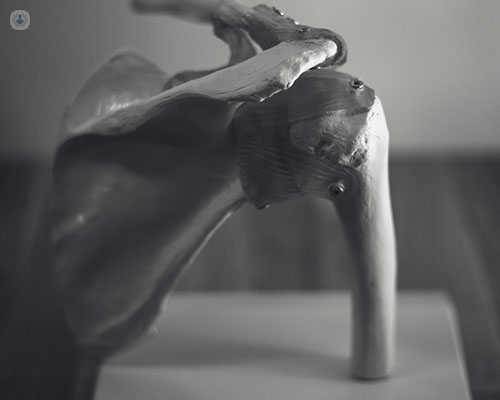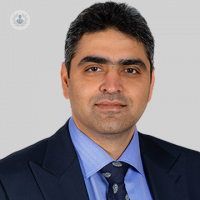An expert's guide to rotator cuff injuries
Autore:In his latest online article, revered orthopaedic surgeon Mr Abhinav Gulihar offers his expert insight into rotator cuff injuries. He explains the symptoms and treatment of these injuries among many other interesting points.

What is the rotator cuff?
The rotator cuff is made up of four muscles and tendons surrounding the shoulder. For the shoulder joint to be strong and stable, these muscles are crucial. Two of the muscles are located at the back of the shoulder, one above the shoulder and one in front. The tendon on top of the shoulder is called the Supraspinatus. This is frequently torn and inflamed.
Why does the rotator cuff tear?
A rotator cuff tear can happen as a result of normal wear and tear, chronic tendon inflammation and occasionally a serious incident such as a fall.
Tears that develop as a result of wear and tear frequently begin tiny and may gradually grow in size over time. Tears that develop after an accident (like a shoulder dislocation) are frequently large tears that grow quickly in size and may become too large to mend within a few months.

Do rotator cuff tears heal?
Most rotator cuff injuries or tears do not heal themselves as the tendon has pulled away from the bone and is no longer touching it. It pulls further and further away from the bone as the tear grows over time.
Are the tears always painful?
Many individuals over the age of 50 to 60 have rotator cuff injuries without any discomfort or dysfunction. Some people may experience the pain slowly increasing as the tears grow in size over time. Inflammation of the ruptured tendons is frequently another cause of pain.
How is a rotator cuff injury diagnosed?
The diagnosis of a torn rotator cuff is typically reached through a focused clinical evaluation and specialised testing. A history of a serious fall followed by extreme shoulder pain and weakness is a strong indicator of a rotator cuff injury. A significant tear would be indicated by a clinical examination that revealed pain during shoulder movements and weakness during certain rotator cuff tests.
To examine the bone anatomy of the shoulder, an X-ray is usually required. An MRI scan is often necessary to determine the size of the rotator cuff tear, the number of tendons affected, and any muscle wasting. An ultrasound scan may also be used to confirm the diagnosis of a tear.

How is a rotator cuff tear treated?
Tears that are less than 1-1.5 cm long or that do not include the entire thickness of the tendons are frequently treatable without surgery. Avoiding certain trigger behaviours or taking a course of anti-inflammatory medications can be explored if the discomfort is mild or infrequent. Supervised physiotherapy and/or steroid injections would make up further non-operative therapeutic options.
Supervised physiotherapy: The goal of physiotherapy is to enhance the function of the intact component of the rotator cuff and shoulder mobility. Exercises that strengthen the deltoid muscle can enhance the shoulder's overall functionality.
Steroid injection: In many cases, a steroid injection into the area around the rotator cuff will offer effective short- to medium-term pain relief, allowing physiotherapy treatment to proceed. Regular injections might cause the tendon tissue to thin, thus we would often advise decreasing the quantity.
Surgical repair: If discomfort does not go away despite nonoperative treatment, surgery is advised. Large tears with severe pain may warrant immediate surgery rather than seeking non-operative treatment first. To fix the torn tendon, arthroscopic or "key-hole" surgery is used. Symptoms that follow surgery typically go away over time. It can take 6 to 12 months to fully heal.
Mr Abhinav Gulihar is a highly-respected consultant orthopaedic surgeon with over 20 years of experience. If you would like to book a consultation with Mr Gulihar, you can do so today via his Top Doctors profile.


